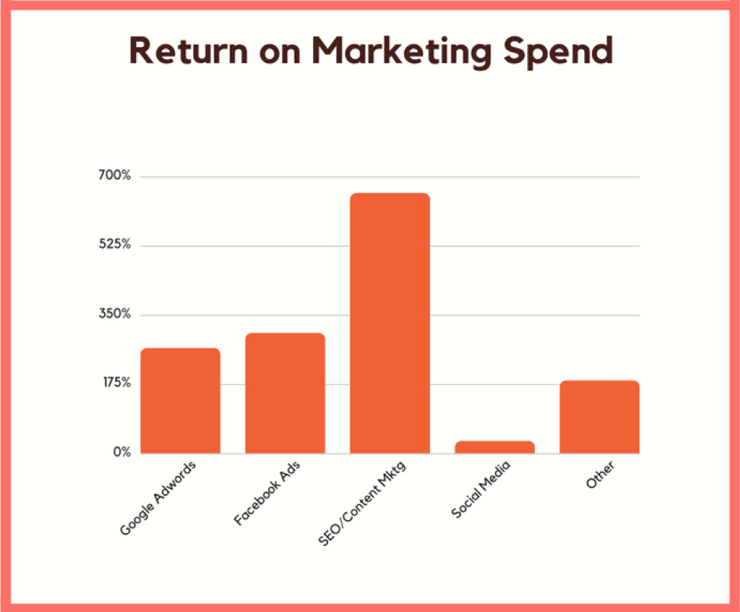



Healthcare software marketing is tough - so you need to make sure you’re getting the biggest bang for your marketing buck. But calculating the return on investment (or ROI) for marketing is notoriously tricky; in fact, only 37% of managers are confident they can prove the impact of their marketing strategies, at least over the short term. In this article, we’ll look at ways that you can measure marketing results - and how you can maximize your ROI to see measurable improvements across the bottom line.
Return on investment seems like a pretty intuitive concept - how much revenue does a given marketing strategy generate? By attributing profit and revenue growth to your marketing campaigns and tactics, you should get a solid idea of what works, what doesn’t, and where you should focus your efforts in the future. Marketing ROI calculations are used to justify marketing spend and budget allocation for future marketing actions and assist marketing decision-making.
Every business is different, but as a rule of thumb, a good marketing ROI is a ratio of 5:1 - meaning that for every $1 you spend, you see an increase of $5 in revenue. Anything below 2:1 is considered unprofitable.
Marketing experts differ on how marketing ROI should be calculated. For some, the only real measure of ROI is cold, hard cash. As healthcare marketing specialist David Marlowe comments in his book, “A Marketer’s Guide to Measuring ROI”:
"'Hard' ROI simply means that results are measured by the actual collected revenues after taking into account the actual cost of the effort. ROI means there is a financial return. If no revenue was generated as a result of the marketing effort, there is no ROI."
For a simple calculation of the financial ROI of a marketing campaign, you take the increase in sales after a given marketing action, subtract what you spent on marketing, and then divide by the marketing cost to get a percentage.
(Sales Growth - Marketing Cost) / Marketing Cost = ROI
This is a nice, easy calculation - but it doesn’t paint a full picture of your marketing performance. For instance, it’s based on the assumption that 100% of your sales growth can be attributed to your marketing efforts - but that is unlikely, especially in an industry like healthcare software with long buying cycles. To get a more accurate picture of how much sales growth can be attributed to marketing, you could consider subtracting your usual sales trend from the overall calculation, giving you something like:
(Sales Growth - Average Sales Growth - Marketing Cost) / Marketing Cost = ROI
Of course, if your usual sales trend is negative, then your ROI could reflect how much you have slowed that trend through marketing actions.
So far, straightforward. But what about marketing efforts which are designed to increase brand awareness, or maintain stakeholder engagement over the sales cycle? These are certainly critical actions in the crowded healthcare IT marketplace - but they might not be directly related to revenue increases. What’s more, a marketing action may take weeks, or (more likely) months, to generate a profit. Finally, you may see leads coming in from one channel as the result of your actions on another - for instance, leads who have been reading your content on LinkedIn may finally decide to buy after seeing a paid ad on Google.
As marketers, we all know that it can be too easy to get bogged down in vanity metrics and forget that the real purpose of marketing is to drive sales results. Our suggestion? Consider other metrics to measure your ROI, but keep things simple - and always have one eye on the bottom line. Some additional metrics to prove marketing efficacy include:
It makes sense - the more leads you have at the top of the funnel, the more sales you should have at the bottom. Use with caution, however - generating leads is not an end in itself. If the leads aren’t a good fit for your product or ultimately don’t convert into customers, they are no guarantee of a return on investment.
Conversion rate, in the context of marketing, refers to how many leads performed the desired action as the result of a marketing campaign. For instance, how many new contacts did you get from your offer? How many people signed up for the webinar? How many people visited your long-form sales page after reading your blog? Again, this is a supplementary data point but cannot act as a stand-in for a financial ROI measurement - after all, leads are not sales.
Another critical factor to figure out - how much does it cost you to acquire a new customer? Using a marketing attribution tool can help you calculate your costs for each marketing channel you use, and thus show you which platforms are the most cost-effective.
Boosting the return on your marketing spend can be tricky. You need to make sure you’re working with a full set of data, have a clear picture of your current success rate, and then build a strategy that addresses all angles.
Here are our top four tips for increasing marketing ROI in the healthcare software industry:
To boost your ROI, you need to understand all of the ways in which prospective customers interact with your business. Calculating your performance at each step of the customer journey will help you to identify any weak spots.
Start by building a customer journey map - a visual representation of your customer’s experience, from the first contact, through various interactions across the different marketing channels you work with, to final purchase. You can use software for this process, but a simple whiteboard and sticky notes will work just as well. Next, add in data for each point on the map, such as the total number of participants, how many convert, and how many drop out. Software like Pointilist can make the process easier for you.
For many businesses, they know where their leads are coming from - but they don’t know which ones are generating the most sales. For instance, leads may come in from their blog, from LinkedIn, from events and from webinars - but of those leads, which are the most likely to buy?
The simplest way to track this is to use conversion tracking. For tracking your web conversions and Google Ads, the most commonly used software is Google Analytics, and it’s easy to see why: “Well-tracked Google Ads accounts have a nearly 50% higher conversion rate than the average account,” reports Jacob Baadsgaard of Disruptive Advertising. However, you’ll need to make sure you track conversion rates for all your channels - including offline sales opportunities such as phone calls and product demos.
For tracking all conversions through to a sale, you will need a solid CRM software, which will enable you to integrate data from your email marketing, social media campaigns, and sales calls into a central repository. A CRM allow you to run automated marketing reports, so you can follow the path to see what lead each customer from initial interest to final purchase.
Improving your marketing ROI will also involve taking a step back and testing - well, everything! Consider A/B testing your marketing messages, to see if your wording is connecting with your target market. Review your data to see if one buyer persona group spends more on your software than another, or if one particular target is easier or quicker to convert. Test how frequently you engage with your leads, and see if sending more (or less!) frequent messages, blogs or calls would be more effective. And finally, pull analytics from each marketing channel you use - and consider culling any that don’t perform for you.
Finally, make sure that you are focusing attention in the right places. Leading digital marketer Neil Patel ran a study on the marketing efforts of 208 companies and identified the most effective marketing tactics to drive ROI. Paid ads (Google Ads, Facebook Ads, etc.) were most effective at generating sales. However, looking at return on investment painted a different picture:

Source: https://neilpatel.com/blog/marketing-wrong/
The lower cost of SEO and content marketing meant that they delivered a higher ROI than paid advertising. However, the marketing strategy that provided the biggest ROI was conversion rate optimization - improving web performance and design to increase the number of web visitors who purchase.
Improving return on investment is tricky, especially in a challenging market like healthcare software. But by starting with a clear idea of what is already working, building a strategy based on customer data, and focusing on what really matters, you will put your business head and shoulders above the rest. If you’d like our help boosting your marketing ROI, please click here to schedule a free 30-minute consultation with one of our marketing specialists.


Rebecca Graves co-founded Spot On in 2012. As a partner and leader of client services, she takes immense pride in being in charge of “client happiness.” The role allows her to wield her problem-solving skills while fostering big-picture perspectives and team building. Rebecca’s more than 35 years of experience have equipped her to translate strategic planning expertise for the advancement of tech companies transforming the healthcare, financial, and legal industries.
Get the latest and greatest posts sent straight to your inbox.


